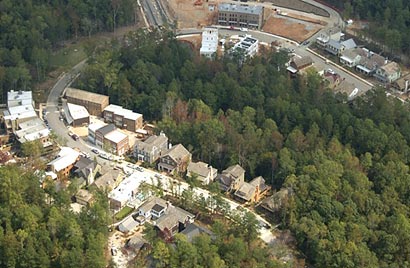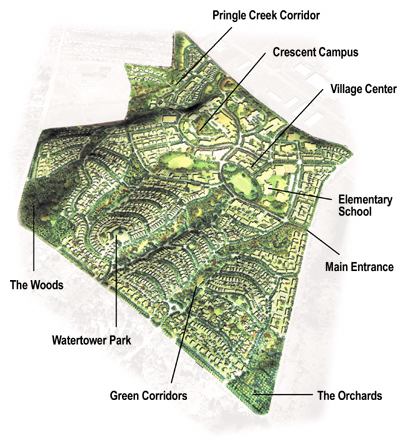Back in the day — back in the late nineteenth and early twentieth centuries — the Garden City concept was actually about gardens. That is, working, productive gardens for every household. Garden City planners said that working gardens supported the health of residents and the environmental and economic sustainability of the town. Fresh produce and fresh flowers were signal images around which the Garden City movement rallied.
But after a few decades, the Garden City label had became more of a marketing term than a literal description. Green spaces were valued for recreation and scenic qualities rather than food production. That remained true of most U.S. suburbs through the next 50 years.
In 1975, Michael Corbett designed Village Homes in Davis, CA, as a model sustainable suburb. The design utilized many complementary strategies, but in particular, Village Homes incorporated gardens and orchards throughout. That was unprecedented for a development of its scale and density.
Today there is once again a rising interest in local food production. And several ambitious Traditional Neighborhood Developments (TND) are recalling the Village Homes model. They combine new urban design principles with a strong focus on, and involvement with, community agriculture.
Serenbe in Palmetto, Georgia
http://www.serenbecommunity.com

Serenbe does not have the usual new urbanist fabric of small blocks; it is designed in a more clustered, more serpentine development pattern. It has extensive private gardens and preserved forests, as well as a 25-acre organic farm that’s also a CSA. But in certain spots it also has that hallmark of urban environments, spatial definition. Browse the photo albums and you’ll see tightly-knit streetscapes that recall the feel of a Main Street or small-town downtowns.
Mountainside Village in Victor, Idaho
http://www.mountainsidevillageidaho.com
A Community Supported Agriculture (CSA) farm is part of this neighborhood. Property owners have priority to buy shares in the farm, or can trade work on the farm for shares of produce. Mountainside Village is laid out for solar orientation and all homes are built to U.S. Green Building Council LEED-H standards.
Agritopia in Gilbert, Arizona
http://www.agritopia.com
Like many suburbs, Agritopia is built on farmland. Unlike most suburbs, Agritopia is retaining a chunk of farmland in the center of the property. The farm has been intensified into 15 acres of organic farms and orchards that supply on-site businesses (a restaurant and a coffee shop).
Notice their disclaimer. It’s probably a good idea to be very clear about farm impacts:
There are farming operations within the community. While this may seem attractive, be prepared for adverse effects, including: dust, compost aromas, noises made by animals or vehicles at early or late hours, manure aroma, dry season with brown ugly patches of garden, delivery vehicles, and so on.
Pringle Creek in Salem, Oregon
http://www.pringlecreek.com
http://www.sustainablefairview.com

Pringle Creek is the first phase of the larger Sustainable Fairview development. All homes have maximum energy efficiency and green materials; some homes have “net zero” energy consumption. A “zero-impact” storm water system is used throughout, including experimental porous pavement to increase water infiltration. The Flower Power Biodiesel Co-Op is now operating and there are plans for a community car-share program. A community organic garden in in place and later phases are envisioned as having orchards, district heating, ecological sanitation systems, on-site geothermal energy, and a recycling/composting facility.
Other Projects
Another project with an agricultural theme is South Village in Burlington, Vermont. South Village is working its way through the entitlements process and is planned around a 35-acre organic CSA farm and native plant nursery. Permanent and seasonal farm housing is also planned. The development will include an ecologically-designed stormwater management system, ecological restoration, and energy efficient building designs.
Also in the entitlements process is Sky in Calhoun County, Florida. The 571-acre site plan will maintain 232 acres as agriculture and converts 105 acres from agriculture to conservation. Most of the 322 homes will be clustered into villages and hamlets. The development will include public gardens, a farmer’s market and incentives for green building techniques.
What other developments are combining walkability, mixed use, and a mix of housing types with a primary focus on agricultural activities such as permaculture, CSAs, or community gardens?
Equally ambitious, if not more so, are individual efforts to retrofit existing suburban residences into permaculture zones. There are plenty of people giving this idea a go, but the most inspiring has to be the Dervaes family of Pasadena, California. They describe their home:
Our homestead supports four adults, who live and work full time on a 66′ x 132′ city lot (1/5 acre).
The yard has over 350 varieties of edible and useful plants. The homestead’s productive 1/10 acre organic garden now grows over 6,000 pounds (3 tons) of produce annually. This provides fresh vegetables and fruit for our family’s vegetarian diet and a source of income.
We operate a viable & lucrative home business that supplies area restaurants and caterers with salad mix, edible flowers, heirloom variety tomatoes and other in-season vegetables. The income earned from produce sales offsets operating expenses and is invested in appropriate technologies, such as solar panels, energy efficient appliances, and biodiesel processor, to further decrease our homestead’s reliance on the earth’s non-renewable resources.
Some forecasters have suggested the suburbs will collapse in the face of rising fuel prices and gasoline shortages. But it seems to me if suburban residents are willing to put energy and ingenuity into their homes like the Dervaeses, then the suburbs will prosper no matter what fuel crises may happen in the future.
Resources
Jason Miller profiles several community garden programs in The Promise of Urban Agriculture.
The American Commuity Garden Association — Growing community through gardening and greening across the United States and Canada.
RUAF Foundation — A global network sharing a common vision on urban development and poverty reduction, and implementing an international program focused on urban agriculture and food security.

I hope that the initiative represented by this site grows. What plans do you have to make it become better known?
Thanks, Andres. I think there are two basic strategies for building readership. One is you follow the daily news and editorialize constantly about it, and trade comments with others who are doing the same thing. The other is to put up content with a longer shelf life, that people use more like a reference.
The idea for this site is closer to the latter. It’s a repository for essays, editorials and presentations that support new urban design practices and principles. It’s a place to collect some thoughts about sustainability and its intersection with urban design. And it’s a place for material I just find inspiring.
I participate in a bunch of blogs, listservs and forums, and whenever I need to support a point that’s not supported by other sources, I can link here instead of repeating myself over and over. With some luck and skill, other people will find the material here to be useful and will do the same.
Glad you found it useful, Elizabeth. There have been more developments along these lines since this was written. For instance, check out this article about the plan for Southlands in British Columbia. Also see the specific plan and the portfolio page for Loma Rica Ranch in Grass Valley, CA, which is in the approvals phase.
The City Farmer News is a fun blog and clicking on the “Book” category turns up some sources. Here’s a more extensive bibliography from the USDA. The Center for Urban Agriculture at Fairview Gardens is a lone outpost of organic farming and education in the suburbs of Santa Barbara.
I found this page to be extremely useful. I am grad student in landscape architecture at UO and am in a joint land. arch. + arch. studio this term. We are investigating opportunities for a project in Damascus, Oregon that will integrate sustainable development and urban agriculture into the comprehensive plan for Oregon’s newest incorporated town. My group and I are currently working on collecting information for precedent studies and were hoping to focus on urban housing + food production. Although there are a number of sustainable development examples in the US, I was feeling somewhat stumped by the relatively few number of progressive examples that truly prioritized food production/urban agriculture. This is especially uncommon in Oregon as our land use laws don’t even allow for “agriculture” land to be a zoning option within the UGB.
Thanks for highlighting a number of great examples. I am inspired and hope to continue researching a topic similar to this for my masters project.